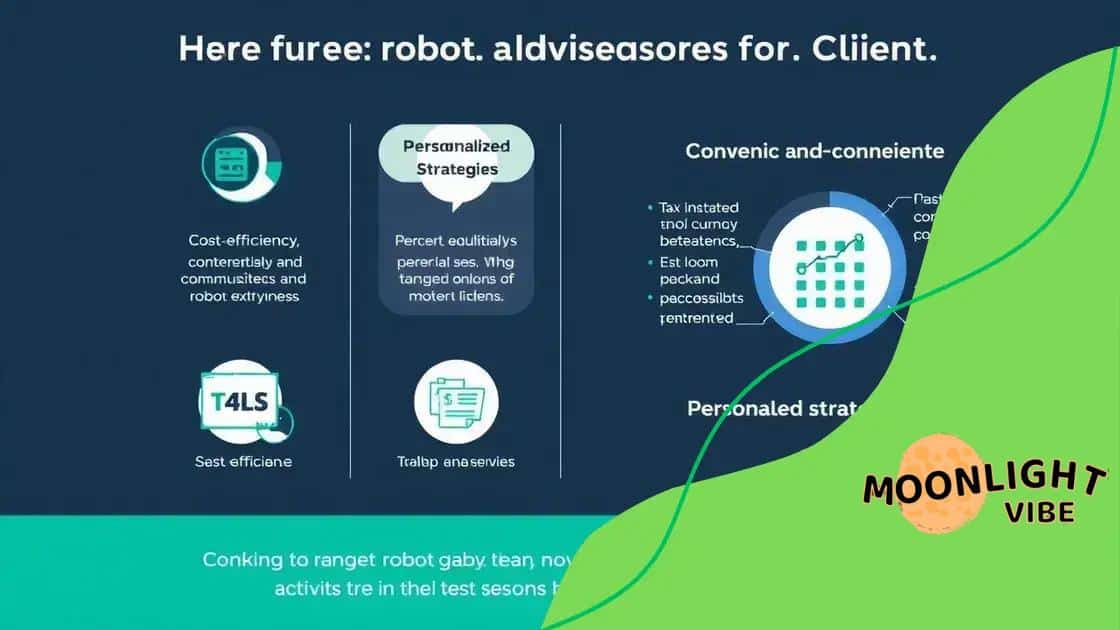Robo-advisors and their role in wealth management

Anúncios
Robo-advisors provide automated investment management solutions that offer cost-effective, accessible, and user-friendly financial services, but they come with limitations such as less personal interaction and standardized strategies.
Robo-advisors are changing the game in wealth management by automating financial services for investors. Have you ever wondered how these platforms can help enhance your portfolio? Let’s dive in!
Anúncios
Understanding robo-advisors
Understanding robo-advisors is essential for anyone looking to invest wisely today. These automated platforms are not just a trend; they are a significant shift in how we manage wealth. By offering a seamless combination of technology and investment expertise, robo-advisors provide investors customized solutions at a lower cost.
What are Robo-Advisors?
A robo-advisor is an online platform that provides automated financial planning services with minimal human intervention. Users typically complete a questionnaire about their financial situation and objectives. Based on these responses, the platform uses algorithms to create and manage a diversified portfolio.
Features of Robo-Advisors
There are several standout features that make robo-advisors appealing to both novice and experienced investors:
Anúncios
- Low fees compared to traditional financial advisors
- Accessibility via online platforms
- Automated rebalancing of portfolios
- Tax-loss harvesting to improve returns
These features enable users to invest with less worry and more confidence. Additionally, the technology behind robo-advisors allows for quick adjustments to market changes, enhancing potential profit while managing risks.
Another important aspect to consider is the user experience. Most robo-advisors offer intuitive interfaces, making them user-friendly for people without extensive financial knowledge. This accessibility is particularly beneficial for younger investors who might be entering the investment space for the first time.
How Robo-Advisors Operate
So, how do these platforms actually operate? First, clients provide personal information such as income, investment goals, and risk tolerance. Then, the robo-advisor analyzes this data and recommends investment strategies.
Once the portfolio is established, the robo-advisor continuously monitors it, making necessary adjustments to maintain alignment with the client’s goals. This ongoing management is one of the reasons why these platforms have gained traction, offering peace of mind to investors.
The investment strategies of robo-advisors
The investment strategies of robo-advisors are designed to meet various client goals while minimizing risks. They utilize advanced algorithms to allocate funds based on different investment profiles, which helps ensure balanced portfolios.
Diversification and Asset Allocation
Diversification is one of the key principles in the strategies employed by robo-advisors. By spreading investments across various asset classes, such as stocks, bonds, and real estate, they reduce the overall risk. The allocation is typically determined by factors like:
- Client’s risk tolerance
- Investment timeframe
- Financial goals
This customized approach ensures that each investor’s needs are addressed effectively. Furthermore, robo-advisors adjust allocations regularly according to market changes, keeping the portfolio aligned with the client’s objectives.
Automated Rebalancing
Another critical strategy is automated rebalancing. As market conditions fluctuate, some assets may perform better than others, altering the desired allocation. Robo-advisors automatically rebalance by selling portions of outperforming assets and buying underperforming ones, maintaining the intended risk level.
This hands-off approach is highly beneficial for investors who might not have the time or expertise to manage their portfolios actively. Additionally, this automation allows for quick responses to market changes, helping to capture gains and limit losses.
Tax efficiency is another area where robo-advisors excel. They employ techniques such as tax-loss harvesting to offset gains with losses, which can enhance net returns for clients. This method further demonstrates the holistic investment strategies implemented by these platforms.
Overall, by leveraging technology, robo-advisors bring a sophisticated level of strategy to investing, making it accessible for everyone from beginners to seasoned investors. The combination of smart algorithms and automated management provides a streamlined experience that caters to a wide array of investment goals.
Benefits of using robo-advisors for clients

The benefits of using robo-advisors for clients are numerous and compelling. These platforms provide an efficient way to manage investments with minimal hassle. For many individuals, especially those new to investing, robo-advisors offer a user-friendly solution.
Cost Efficiency
One of the most significant advantages of robo-advisors is their lower fees compared to traditional financial advisors. With fewer overhead costs, these platforms are able to provide services for a fraction of the price. This makes investing more accessible to a wider audience.
Convenience and Accessibility
Robo-advisors are available 24/7, allowing clients to access their accounts and make adjustments at any time. This flexibility is particularly useful for busy individuals who may not have time to meet with a financial advisor in person. With just a few clicks, clients can view their investments, adjust their risk profiles, or add funds.
- Investing from anywhere with an internet connection
- Easy-to-use mobile and web platforms
- Automated portfolio management
When considering investment solutions, many people prioritize ease of use. Robo-advisors are designed to be straightforward, simplifying the investment process for users.
Personalized Investment Strategies
Another key benefit is the personalized investment strategies that robo-advisors provide. After clients fill out a questionnaire about their financial goals and risk tolerance, the platform creates a tailored investment plan. This personalized approach can help maximize returns based on individual circumstances.
Additionally, robo-advisors continuously monitor investments and automatically rebalance portfolios when necessary. This ensures that clients stay on track with their investment objectives without having to manage everything manually.
Tax efficiency is also a crucial component of the benefits offered by robo-advisors. Many platforms utilize strategies like tax-loss harvesting, which can help reduce tax liabilities and improve overall returns.
Limitations and considerations in using robo-advisors
While robo-advisors offer many benefits, there are also limitations and considerations that clients should keep in mind. Understanding these factors can help investors make informed decisions about their financial management.
Limited Personal Interaction
One significant limitation is the lack of personal interaction. For some investors, discussing their financial situation with a human advisor can provide reassurance and tailored advice. Robo-advisors primarily rely on algorithms, which means clients may miss out on the emotional support that comes from speaking with a live professional.
Investment Strategies and Flexibility
Robo-advisors typically follow standardized investment strategies. While this can be efficient, it may not suit every investor’s unique needs. Some clients may prefer more customized portfolios that take into account specific preferences or investment philosophies. This can be a crucial consideration for individuals seeking more control over their investments.
Additionally, the strategies used by robo-advisors are based on historical data and algorithms. This means they may not always react perfectly to sudden market changes or crises.
Fees and Costs
Though robo-advisors generally have lower fees than traditional advisors, they still charge management fees. These fees can eat into returns over time. It’s essential for investors to understand all costs involved, including potential fees for transactions.
Another consideration is the minimum investment required by some robo-advisors. While many platforms are accessible, some may require larger initial investments, which could be a barrier for novice investors.
Market Risks
Investors should also remember that, like any investment, robo-advisors come with risks. Economic downturns can negatively affect the performance of portfolios managed by these platforms. Although they are designed to mitigate risks through diversification, they cannot eliminate them completely.
Furthermore, the automated nature of robo-advisors means that clients may not gain as much experience or understanding of investing themselves, which can be a disadvantage in the long run.
The future of robo-advisors in wealth management
The future of robo-advisors in wealth management looks promising as technology continues to evolve. These platforms are increasingly integrating artificial intelligence, which improves their ability to provide tailored investment advice and enhances overall user experience.
Advancements in Technology
With the rise of machine learning, robo-advisors are becoming smarter. They analyze vast amounts of data to refine investment strategies. These advancements empower clients to receive increasingly customized portfolio management without needing human intervention.
Increased Accessibility
The future also holds the potential for greater accessibility. As more individuals become interested in investing, robo-advisors will continue to simplify the process. By making investing more approachable, they aim to attract a broader audience, especially younger generations who are tech-savvy.
- Lower barriers to entry with minimal investment requirements
- Enhanced user interfaces that are easy to navigate
- Educational resources to help users understand investing
These features make it easier for novice investors to get started. As more people recognize the value of investment, the demand for user-friendly platforms will grow.
Integration with Financial Services
The future of robo-advisors may also include deeper integration with various financial services. This could lead to comprehensive financial planning tools that encompass budgeting and saving, in addition to investment management. Clients may expect more holistic solutions from these platforms.
Moreover, partnerships between robo-advisors and traditional financial institutions could expand their offerings, resulting in more diverse financial products. This integration would ultimately benefit clients by providing a one-stop shop for all their financial needs.
Sustainability and Ethical Investing
As sustainability becomes more important, robo-advisors are likely to focus on socially responsible and ethical investing. Clients may seek options that align with their values, and robo-advisors can cater to these preferences through dedicated portfolios that focus on environmental, social, and governance (ESG) criteria.
By embracing sustainable practices, robo-advisors can attract clients who are passionate about making a positive impact while investing.
Conclusion: In summary, robo-advisors present a modern and efficient way for people to manage their investments. They provide cost-effective solutions, making investing accessible to everyone. While there are limitations, such as less personal interaction and standardized strategies, the benefits often outweigh the drawbacks. As technology continues to advance, the future of robo-advisors looks bright, with promising innovations in personalized services and sustainable investing. Understanding these elements can help clients make informed decisions about their financial future.
FAQ – Frequently Asked Questions about Robo-Advisors in Wealth Management
What are robo-advisors?
Robo-advisors are online platforms that provide automated investment management services with minimal human interaction.
How do robo-advisors reduce investment costs?
They leverage technology to automate processes, which allows them to charge lower fees compared to traditional financial advisors.
Are robo-advisors suitable for beginners?
Yes, robo-advisors are designed to be user-friendly, making them an excellent choice for novice investors.
What are the risks associated with using robo-advisors?
Like any investment, robo-advisors carry risks, including market fluctuations, and they may not offer personalized advice like human advisors.





